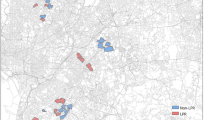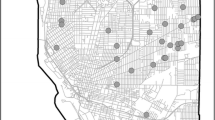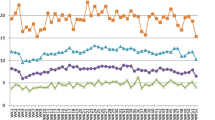Abstract
Objectives
To determine optimal methods of patrol with license plate readers (LPRs) for maximizing detection and apprehension.
Methods
Data from two randomized experiments were jointly analyzed. In the first, a four-officer squad conducted short daily operations to detect stolen and other vehicles of interest at randomly selected road segments (averaging 0.6 miles) at varying times of day for 2 weeks per location. Based on random assignment, the unit operated with LPRs on some routes and conducted extensive manual checks of license plates on others. In the second experiment, the squad conducted similar operations focused on larger hot spot areas (averaging 1 mile2) using the same research design. The first experiment emphasized longer surveillance on primary hot routes, while the second emphasized shorter visits to the main hot routes and more roving surveillance around these routes. Officer log data were used to examine the likelihood that the patrols resulted in detection of wanted vehicles, arrests, or recoveries of stolen vehicles. Chi-square tests and multivariate logistic regressions were used to examine LPR performance across experiments.
Results
LPRs increased the likelihood of all outcomes (which were generally rare) in both experiments, though only the effects on detections were statistically significant. Differences across the experiments were not statistically significant, but LPR performance was generally better during the second experiment, particularly with regard to how much LPR use improved performance over manual plate checks.
Conclusions
Results suggest LPR patrols emphasizing roaming operations within larger hot spot areas may be most optimal, but the effects of LPR patrols may not be substantial without large-scale deployment.
Similar content being viewed by others
Notes
This analysis was based on reports of nearly 1700 vehicles that were both stolen and recovered in the city during a 1-year period. Hot routes were selected based on the shortest travel time between each theft and corresponding recovery location as a likely estimate of the thief’s route.
The decision to work each route for 2 weeks was based on the agency’s desire to spread the use of the LPRs over several locations, the research team’s desire to include a large sample of hot spots in the experiment, and the auto theft unit’s judgment that working a given location for more than 2 weeks brought diminishing returns with regard to finding stolen vehicles.
The boundaries for these zones were determined based on the geographical analysis conducted for the first experiment and the officers’ expert judgment and were designed around roadways and other natural divisions. As with the routes used in the first experiment, the zones contained a mixture of residential and business areas and different types of roads (interstate roads, highways, and residential streets).
These estimates are based on average plates scanned or entered per patrol. As a caveat, these figures are based on sums for the auto theft unit and include repeat scans and entries across officers.
Assignment to the LPR and non-LPR conditions was done using a stratified random allocation procedure in which routes and zones were randomized within statistical blocks to reduce variability across groups. Stratification variables used in the first experiment included length of the hot route, speed limit of the route, ease of surveillance for running plate checks (as graded by the participating officers), and whether the route was determined based on geographical analysis or by designation by detectives. Stratification variables used in the second experiment included the size of the zone, whether or not the zone contained a major freeway, and the number of auto thefts in the zone during the prior year. Analyses confirmed that the LPR and non-LPR locations were balanced across the stratification variables for each experiment. The LPR and non-LPR routes and zones were also statistically equivalent with respect to their levels of auto theft prior to the experiments. The assignments to LPR and non-LPR conditions were made at the outset of each experiment and, consequently, were not based on the number of auto thefts associated with the locations during the specific weeks they were patrolled. The analysis assumes this factor was balanced across the groups via randomization.
A small number of log entries (< 2%) were removed from the analysis due to missing data.
More specifically, seasons were coded as winter (January through March), spring (April through June), summer (July through September), and fall (October through December). (Note that Mesa has warm winters and very hot summers.) Patrols were coded as afternoon patrols if they started before 5 pm, evening patrols if they started between 5 pm and 9pm, and night patrols if they started at or after 9 pm.
The outcome variable in these models is the logarithm of the odds of the event of interest. The odds are defined as p/(1 − p), where p is the likelihood of the event. Exponentiation of the coefficients reveals the multiplicative relationship of the variable to the odds of the event. Subtracting one from this number and multiplying the difference by 100 gives the percentage change in the odds.
In the Mesa experiments, the officers’ productivity was also constrained by the experimental design, which required them to work assigned locations at assigned times (to ensure comparability across conditions) rather than target operations based on current crime analysis and traffic patterns. Nonetheless, this limitation applied to the LPR and non-LPR patrols in both phases, thus facilitating valid comparisons. It is also worth noting that these analyses compare LPR use to the use of extensive manual license plate checks conducted by a specialized unit. In comparison to normal patrol operations (with more sporadic license plate checks), the productivity gains from LPR use would likely be greater. LPR effects might also be greater in other nations (like the United Kingdom) where license plates are standardized.
References
Cohen, I., Plecas, D., & McCormick, A. (2007). A report on the utility of the automated license plate recognition system in British Columbia. British Columbia: University College of the Fraser Valley.
Koper, C. S. (1995). Just enough police presence: reducing crime and disorderly behavior by optimizing patrol time in crime hot spots. Justice Quarterly, 12, 649–672.
Koper, C. S., & Lum, C. (2019). The impacts of large-scale license plate reader deployment on criminal investigations. Police Quarterly. https://doi.org/10.1177/1098611119828039 Published online Feb. 12.
Koper, C. S., Taylor, B. G., & Woods, D. J. (2013). A randomized test of initial and residual deterrence from directed patrol and use of license plate readers at crime hot spots. Journal of Experimental Criminology, 9(2), 213–244.
Koper, C. S., Lum, C., Willis, J., Happeny, S., Johnson, W. D., Nichols, J., Stoltz, M., Vovak, H., Wu, X., & Nagin, D. (2018). Evaluating the crime control and cost-benefit effectiveness of license plate reader technology. Report to the National Institute of Justice, U.S. Department of Justice. Fairfax: Center for Evidence-Based Crime Policy, George Mason University.
Lum, C., & Koper, C. S. (2017). Evidence-based policing: translating research into practice. Oxford: Oxford University Press.
Lum, C., Hibdon, J., Cave, B., Koper, C. S., & Merola, L. (2011). License plate reader (LPR) police patrols in crime hot spots: an experimental evaluation in two adjacent jurisdictions. Journal of Experimental Criminology, 7, 321–345.
Lum, C., Koper, C. S., Willis, J., Happeny, S., Vovak, H., & Nichols, J. (2018). The rapid diffusion of license plate readers in U.S. law enforcement agencies. Policing: An International Journal, 42(3), 376–393. https://doi.org/10.1108/PIJPSM-04-2018-0054.
Ohio State Highway Patrol (2005). Automatic plate reader technology. Planning Services Section, Research and Development Unit.
Ozer, M. M. (2010). Assessing the effectiveness of the Cincinnati Police Department’s automatic license plate reader system within the framework of intelligence-led policing and crime prevention theory. Ph.D. dissertation. Cincinnati: School of Criminal Justice, University of Cincinnati.
PA Consulting Group. (2004). Driving down crime: denying criminals the use of the road. London: Author.
PA Consulting Group. (2006). Police standards unit: thematic review of the use of automatic number plate recognition within police forces. London: Author.
Potts, J. (2018). Assessing the benefits of automated license plate readers. The Police Chief, (March 2018), 14–15.
Taylor, B., Koper, C. S., & Woods, D. J. (2011). Combating auto theft in Arizona: a randomized experiment with license plate recognition technology. Report to the National Institute of Justice, U.S. Department of Justice. Washington, DC: Police Executive Research Forum.
Taylor, B., Koper, C. S., & Woods, D. J. (2012). Combating vehicle theft in Arizona: a randomized experiment with license plate recognition technology. Criminal Justice Review, 37(1), 24–50.
Telep, C. W., Mitchell, R. J., & Weisburd, D. (2014). How much time should the police spend at crime hot spots? Answers from a policy agency directed randomized field trial in Sacramento, California. Justice Quarterly, 31(5), 905–933.
Acknowledgments
The authors thank the Mesa, AZ Police Department (MPD) for its participation in the project, particularly auto theft unit officers James Baxter, Joel Calkins, Stan Wilbur, Brandon Hathcock, and Cory Cover (supervisor). The authors also thank Dr. Yongmei Lu for contributing geographic analyses to the project design, Daniel Woods for assistance in managing the data, and Cynthia Lum for comments on an earlier draft of this paper.
Disclaimer
The views expressed here are those of the authors and should not be attributed to the U.S. Department of Justice, the Mesa, AZ Police Department, the authors’ respective institutions, or any of the aforementioned individuals.
Funding
The fieldwork for this project was supported by grant 2007-IJ-CX-0023 from the National Institute of Justice (Office of Justice Programs, U.S. Department of Justice).
Author information
Authors and Affiliations
Corresponding author
Ethics declarations
Conflict of interest
The authors report no conflicts of interest.
Additional information
Publisher’s note
Springer Nature remains neutral with regard to jurisdictional claims in published maps and institutional affiliations.
Electronic supplementary material
ESM 1
(DOCX 14 kb)
Rights and permissions
About this article
Cite this article
Koper, C.S., Taylor, B.G. & Park, S. Optimizing the geographic deployment of hot spot patrols with license plate readers. J Exp Criminol 15, 641–650 (2019). https://doi.org/10.1007/s11292-019-09366-1
Published:
Issue Date:
DOI: https://doi.org/10.1007/s11292-019-09366-1




